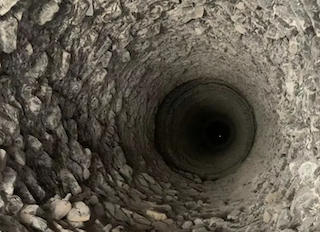Causes Of Coking When Burning Fluorine-Containing Waste In Rotary Kilns And Its Impact On Refractory Materials
Dec 27, 2023There are two main types of coking situations in the process of incineration waste treatment in rotary kilns, including: the first is the coking of low-melting point salts in the furnace. During the incineration treatment process, the waste will decompose at high temperatures. The decomposed elements will recombine at high temperatures to form some low-melting point salts (mainly a combination of alkaline components and halides). These low melting point salts are very viscous at high temperatures, and they will stick to themselves and other substances to cause coking in the rotary kiln.
The second coking method is mainly caused by the solidification of ash when exposed to cold. Cold air penetrates into the gap in the sealing plate at the slag outlet at the end of the kiln and water evaporates in the slag remover, causing the local temperature to drop and cause coking.
During the process of waste incineration, the waste will decompose at high temperatures, and water-soluble alkali metals will rapidly precipitate. Gaseous alkali metals will easily adhere to the surface of coarse particles, forming a high-viscosity film layer, and interact with Cl and S in the gas phase. The gas phases combine to form low melting point substances. These low melting point salts are very viscous at high temperatures, and they will stick to themselves and other substances to cause coking in the rotary kiln. In addition to chlorides and sulfates containing Na, K, and Ca, there are also small amounts of heavy metal elements (Pb and Zn). They have lower melting temperatures (ZnCl2 is 290°C, PbCl2 is 510°C) and are more likely to stain the wall. , the adhered ash particles form slagging. #rotary kiln#
1. The principle of coking of low melting point salts in the furnace
In addition, if serious coking of low-melting-point salt has occurred in the kiln, the combustion temperature of the rotary kiln can be appropriately lowered. After the low-melting-point salt is successfully burned and enters the slag discharging system, the temperature in the kiln can be adjusted to the normal operating temperature. Understanding the characteristics of the formation of low-molten salts is very important to control the coking caused by the bonding of low-molten salts. Generally, the ash and slag characteristics of the waste can be determined through elemental analysis of the waste. During the process of waste incineration, the composition of salt substances will be changed due to chemical decomposition with other elements, and they will be recombined with other components to form new components.
A typical example is the combination of alkaline components (sodium, potassium) and halides (chlorine, fluorine). Most of the waste that needs to be treated contains chlorine or fluorine. When other wastes that are treated contain sodium or potassium, low-molten salts will form. A typical sodium salt (NaCl) has a melting point of a single component of 800°C. When sodium and chlorine are chemically combined it becomes so viscous that it sticks to itself and to other substances. Once a large lump or oblong is formed, it will bind more other materials. These sticky substances may not be fully burned and decomposed before they are completely covered. They will fall into the ash treatment system and cause blockage.
2. Impact on rotary kiln refractory materials
Waste is burned in a rotary kiln and generally goes through several stages such as drying, pyrolysis, combustion, and burnout. After these stages, the harmful components in the waste are fully decomposed and destroyed under the action of high temperature, forming high-temperature flue gas and slag. These high-temperature flue gases and slag will cause corrosive damage to the refractory materials built in the rotary kiln. Therefore, the refractory materials of the rotary kiln for waste incineration treatment should also have the following characteristics:
(1) High temperature resistance. Able to operate in high temperature environments above 800°C for a long time.
(2) High strength and good wear resistance. The refractory materials in the rotary kiln need to have a certain mechanical strength to withstand the expansion stress at high temperatures and the stress caused by the deformation of the rotary kiln shell. At the same time, because the movement of waste in the kiln and the friction of dust in the flue gas will cause wear and tear on the refractory materials in the kiln, the refractory materials are required to have strong wear resistance.
(3) Good chemical stability to resist erosion by chemicals in flue gas. The compounds that have the greatest impact on the quality of refractory materials are alkali (potassium, sodium), halogen (chlorine, fluorine) and sulfur compounds.
(4) Good thermal stability, able to withstand alternating thermal stress in the incineration state. When the furnace is stopped, started and the rotation operation is unstable, the temperature changes in the kiln are relatively large, which requires that the refractory materials must not crack or peel when the temperature changes drastically.
(5) The thermal expansion stability is better. Although the thermal expansion coefficient of the rotary kiln shell (usually carbon steel plate) is greater than that of the rotary kiln refractory material, the shell temperature is generally around 150~300°C, while the temperature that the refractory material withstands is generally above 800°C, so This may cause the refractory material to have a greater thermal expansion than the rotary kiln shell and fall off easily.
(6) The porosity should be low. If the porosity is high, flue gas will penetrate into the refractory material and corrode the refractory material.
At present, in waste incineration projects, rotary kilns are usually built with refractory bricks, and only refractory castables are used at both ends of the kiln. The commonly used refractory bricks mainly include zirconium-containing high alumina bricks, zirconium-chromium corundum bricks, etc. The castables are mainly chromium refractory castables, and in recent years, silicon carbide castables have been the main ones. The selection can be based on the composition of the hazardous waste.